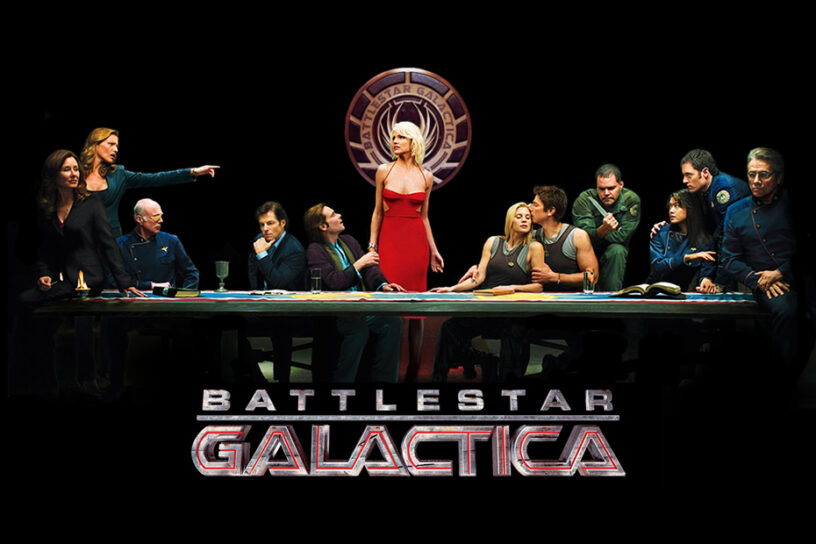Table of Contents:
If you’ve read a few of my posts on this site, you might be aware that I am a big Doctor Who fan. In fact, it’s my number one favourite TV show of all time. But I do have other favourites and I love them just as much* as Doctor Who (*well, not quite, just a hair’s breadth less!).
Top of the list of those other shows is Battlestar Galactica: and the 2003 re-imagined series celebrates its 20th Anniversary this year.
When I say Battlestar Galactica, I do mean all of it. From the 1978 Glen A. Larson series through Galactica 1980 to the 2003 Ronald D. Moore re-imagining and culminating (so far) with 2012’s Battlestar Galactica: Blood and Chrome. And I love every single minute of it! (Yes, including the hated Galactica 1980 and the much maligned Caprica!)
For full and extensive information about all of the versions of Battlestar Galactica, read the Wikipedia page.
Galactica and I
It’s October 1978 on the British television channel ITV. A new show from the US: Battlestar Galactica, is making its debut in the UK.
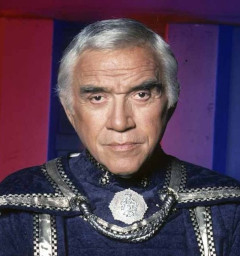
Why ITV? The US television network ABC had a long-running association with the British channel ITV. A good deal of Gerry Anderson shows, such as Thunderbirds and Stingray were sold to ABC for broadcast in the US along with many other shows, since the 1960’s. And that arrangement worked both ways – US-made shows like Buck Rogers and Battlestar Galactica were sold to ITV for broadcast in the UK.
The great thing about that arrangement was that there was very little delay between shows like Battlestar airing in the US and then airing in the UK. Unlike the huge delays for some shows (like Star Trek: The Next Generation) to appear in the UK, this ABC-ITV arrangement meant that we could watch Battlestar not long after it had aired for the first time in the US.
And in October 1978, I remember having to “negotiate” with my parents in order to watch it. Although ITV was watched in our house, it wasn’t often. We were a BBC family. Any viewing of “the other channel” had to be justified and authorised.
Bear in mind that in 1978, there were three TV channels in the UK. BBC1, BBC2 and (the regional) ITV. There was no satellite or cable television and there were no video recorders or PVRs. If you wanted to watch a programmes on TV, you had to watch it when it was broadcast, you couldn't pause it or rewind. You watched it, or you missed it.
I think it was on around 6:30 or 7pm in order to capture the younger viewers before bedtime, luckily my Dad and I were both sci-fi fans, so there wasn’t much negotiation to be done.
So we settled and watched the first series, as it aired.
There be spaceships!
Up until that point, the only similar programmes I’d seen were Star Trek, Doctor Who and Blake’s 7. (Blake’s 7 had aired in January 1978.) I’d heard about some film called “Star Wars” that was released in 1977, but I hadn’t seen it (and it wouldn’t be available for me to see for a few years).
Blake’s 7 – although superb, utterly brilliant (and Servalan) – was a BBC production and therefore shared the same resources in terms of props, set designs and special effects as Doctor Who.
I’d seen Star Trek (to an extent) by 1978 – that aired on the BBC in the UK, so I could watch that if it was on! I didn’t (and still don’t) care much for the original series, although I do (now) enjoy the mythology of Kirk and Spock. (I also very much enjoyed all of the Star Trek Films!).
When Battlestar arrived however, this was an entirely different kettle of fish. There were slightly better space effects than Star Trek (streets ahead of Doctor Who and Blake’s 7 😁). There was better set design and production values than anything I’d previously seen. However the thing that clinched it for me was the overall premise of the series.
Cylons!
There were robots. With robot voices. And they were evil. And they had slidy red lights for eyes (with a sound effect attached!). This was right up my street.
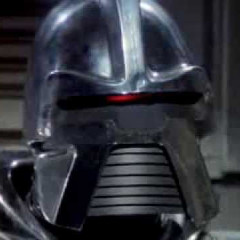
It was the whole concept of a similar race of people from hundreds of years ago (and thousands of light years away) who had to flee from their home worlds (the Twelve Colonies) due to an ongoing war with the Cylons. The Cylons were led by the Imperious Leader, who had his human spy – Baltar. The Imperious Leader incidentally, voiced by none other than Patrick McNee, star of another favourite series of mine: The Avengers.
The stories were pretty much standard stuff for this type of series at the time. But I loved the setting (the Galactica), I loved the chrome Cylons with the sliding red eye and I loved the language. This was a different set of humans, not from Earth as we know it. In order to reinforce that, certain words were changed deliberately to reflect that. For example the passage of time was measured in yahrens, sectars and centons. There are voltons and wavelons (voltage and wavelength) metrics and metrons (kilometres and meters). In fact the altered and facsimile language of that original series was peppered throughout the episodes. Felgercarb – uttered by Dirk Benedict’s Starbuck many times – was my favourite ersatz word.
That had never been done before as far as I knew. Even on Doctor Who, things were near enough called the same (with the exception of the Daleks, whose unit of time was called a rel). This impressed me greatly (I was easily impressed in my youth!).
The music was good too – but nothing out of the ordinary for the time. Stu Phillips did an amazing job with the Galactica theme, a theme which is still recognisable today. The incidental music – never overbearing – was much of the same orchestral arrangements and it stayed where it should have – in the background.
All in all, my teen self enjoyed Battlestar Galactica very, very much. Then after 24 episodes – it stopped.
Galactica 1980
All was (kind-of) not lost. Though the “main” series was cancelled (due to the rising costs of making the episodes and declining ratings), a second series called Galactica 1980 (or Galactica 80) was commissioned.
The premise of this was that the Galactica and it’s rag-tag fleet had reached Earth (in 1980), 30 years after the original series. 10 episodes ensued in which there was a bit of time travel to the Second World War and a bunch of super-children played baseball and took apart a TV camera. Very few scenes were set in space, very few spaceships were on display. Footage from the previous series (attacking Cylon ships, for example) was reused. Most of the action took place on Earth, in 1980. (Obviously done to keep costs down.)
Hardly any of the original actors were engaged for the new series. Lorne Greene reprised Adama and Herb Jefferson Jr. reprised Boomer. Dirk Benedict reprised Starbuck for just one episode (the best of the 10!).
The show was almost universally panned.
Although the series did get aired on ITV during the early 1980’s, I missed it completely and only caught up with it much, much later on. And much later on, I fully understand why it got such a bad reception!
Then there was more: the re-imagining
[Imagine a short film clip indicating the passage of time]
Over 20 years later, there was internet. There were magazines dedicated to sci-fi programmes. More importantly, there was news. Battlestar news.
Battlestar Galactica was to be “re-imagined” into a new miniseries, comprising of two 1.5 hour episodes. And it was to be broadcast in 2003 on the Sci-Fi Channel. Which I could get through my Sky satellite.
Even in the UK, this was widely reported amongst the sci-fi community, so I knew it was coming. The regular sci-fi magazines carried pictures on their front pages and articles within. Me – wishing to remain spoiler-free (because I don’t do the spoiler thing – I like to go in without prior knowledge) I read none of those articles until after the event. Then I read all of them.
What I didn’t know, was just how much impact that new miniseries would have.
The re-imagining
The re-imagined Battlestar Galactica has it’s UK network premiere on February 17th 2004 on Sky 1. I was lucky enough to be able to watch it almost as it was shown in the US, and have a copy to watch again, if necessary.
Expectations
Recalling the original series, I did have some expectations:
- There’ll be a Battlestar (hopefully called Galactica!). And vipers.
- There’ll be spaceships. More than one – comprising the rag-tag fleet escaping from the Cylons on their way to Earth.
- Adama will still exist and hopefully the rest of the main characters (Tigh, Starbuck, Apollo, Boomer). Not bloody Boxey though. Please.
- By the time the miniseries aired, I’d seen (and loved) the Stargate film (1994) and I’d been graced with the sublime Stargate SG-1 (1997). So I had certain production value expectations, in terms of props, special effects and costumes.
Of course, I was hoping there were going to be some good stories and some good acting.
The miniseries
It all started with that three hour miniseries (2 x 1.5 hours). This was clearly made to set up the whole premise of the series that was to come, so watch it, I did. And then I watched it again. Mainly to make sure I’d seen what I thought I’d seen.
What I saw was this:
- Oh yes, there was a Battlestar. (And it was called Galactica.) There were vipers (not just one set, but several marks, or types). There were raptors too all on the Galactica.
- As expected, there were spaceships. Lots of them, some of them based on the original series fleet (big smile there!).
- There were other Battlestars originally, but we didn’t get to see many. (A bit later on in the series of course, we’d see the Pegasus. In full.)
- Adama, Tigh, Starbuck, Apollo and Boomer all still existed (more of those in a bit).
- Fabulous production values. The sets, the costumes, the CGI was magnificent!
One of the (many) things that had me hooked straight away was this: human looking Cylons. Cylons that looked like humans. That was, of course the opening scenes of the miniseries. We saw what was to become a Number Six model blow up a space station – with the Number Six still in it.
Wow. Just wow. This, I thought, has so much potential. I was absolutely, inexorably, utterly hooked. Line and sinker.
What followed after that mini series was aired were 74 episodes across four full seasons of what is generally considered to be one of the best television dramas to be aired on US television. 74 episodes and two films (Razor and The Plan) and not forgetting Blood & Chrome and Caprica.
Quoting Wikipedia:
The series received critical acclaim at the time and since, including a Peabody Award, the Television Critics Association’s Program of the Year Award, a placement inside Time’s 100 Best TV Shows of All-Time and 19 Emmy nominations for its writing, directing, costume design, visual effects, sound mixing and sound editing, with three Emmy wins (visual effects and sound editing). In 2019, The New York Times placed the show on its list of “The 20 Best TV Dramas Since The Sopranos”, a period many critics call a “golden age of television.
And just what did we get “for our money”?
Billed as a re-imagining it actually wasn’t too far removed from the original initial story back in 1978.
The Story
The underlying driver behind the whole series was the same as the original series:
It’s set in a distant star system, where a civilization of humans lives on a group of planets known as the Twelve Colonies of Kobol. In the past, the Colonies had been at war with an android race of their own creation, known as the Cylons. With the unwitting help of a human scientist named Gaius Baltar (James Callis), the Cylons launch a sudden sneak attack on the Colonies, laying waste to the planets and devastating their populations.
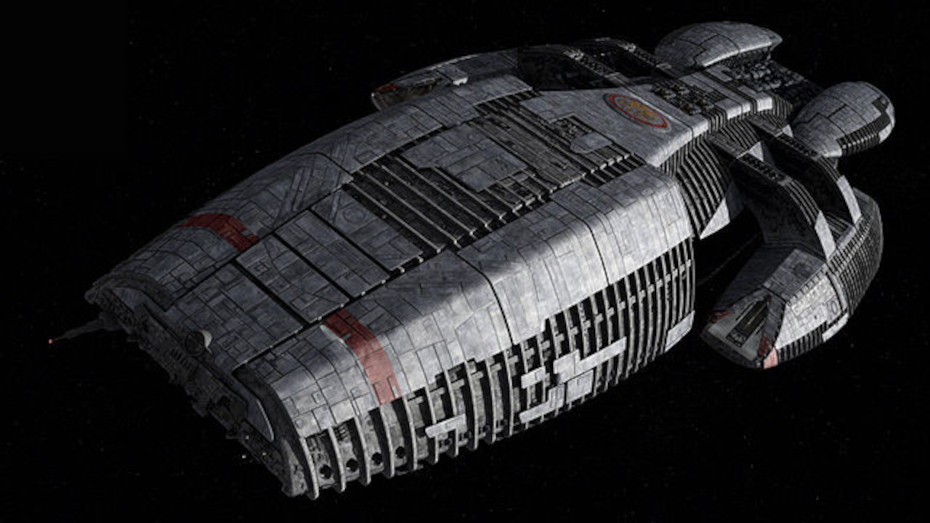
Out of a population of several billion, there are about 50,000 human survivors; most were aboard civilian space ships that were not near the initial attacks. Of all the Colonial Fleet, the Battlestar Galactica appears to be the only military capital ship that survived the attack. Under the leadership of Colonial Fleet officer Commander William “Bill” Adama (Edward James Olmos) and President Laura Roslin (Laura McDonnell), the Galactica and its crew take up the task of leading the small fleet of refugee survivors into space in search of a fabled thirteenth colony known as Earth.
Whilst both the original and the re-imagined series did end up on Earth eventually, they get there by completely different story routes. The most notable difference being the introduction of the “human” Cylons and the concept of Cylon resurrection in the re-imagined series.
The very best thing about it was unlike the original series, the re-imagined series avoided the use of the usual sci-fi fare of space-lasers, laser guns and the original series terminologies of “yahren” and “voltons” etc. There are no space aliens or green wobbly blobs. There are however, bullets, rail guns, rifles, pistols, missiles and nuclear weapons. The antagonists are either CGI Cylons, or the man-made human Cylons. As I recall (and I might be wrong!) the only concession to the original series terminology is the use of “dradus”.
No story of the week?
Unlike the original series there is no story of the week format (Boxey loses his dog, Starbuck loses his latest girlfriend, Adama grows a beard etc.).
Most of the stories deal with the apocalyptic fallout of the destruction of the Twelve Colonies on the survivors, and the moral choices that the leaders (Adama, Roslin) must make as they deal with the decline of the human race and their war with the Cylons.
Underpinning the primary story of the journey from Caprica to Earth, there are many sub-plots and story arcs that portray the concept of perpetuated cycles of hate and violence driving the human-Cylon conflict, and religion, with the implication of a “God” whose possibly angelic agents (the Number Six of Baltar’s visions) appear to certain main characters.
Over the course of the four series, the fleet faces constant Cylon attacks and internal struggles, with conflicts over politics, faith, and survival ethics. Trust issues arise when it’s revealed that Cylons look like humans and some are unknowingly hidden within the fleet. Key characters, such as Captain Kara “Starbuck” Thrace, fighter pilot Lee “Apollo” Adama, and scientist Gaius Baltar (who unwittingly helped the Cylons during the initial attack), undergo significant arcs as they grapple with loyalty, duty, and identity.
A bumsqueak at every turn
I mentioned earlier that the series was nominated for several Emmys for it’s writing amongst others. In my opinion, it should have won every single the one of them, as the viewer is definitely not left wanting.
Throughout the series, the tension levels are set to maximum. In every single episode, there are the “bumsqueak” moments, and they work on several layers. From all-out attacks from Cylon raiders to Kara returning to Caprica to the torture of Colonel Tigh. Those moments where you don’t notice you’re holding your breath, until your brain screams “breathe” and your bum unclenches. There are many of these moments and they are magnificent.
There wouldn’t be a bumsqueak without a Bear
You can film any amount of moments stuffed to the brim of tension, however the single element that raises and accentuates that tension to bumsqueaky point is… music.
Bear McCreary is the composer responsible for providing the music for the entire franchise and the one responsible for raising the tension (usually to 11) in those bumsqueak moments. Like the avoidance of the usual sci-fi elements of lasers and technobabble, the music for the series avoids all the usual synths and wobbly sound generators. Instead, we are treated to expansive orchestras, and lush sound design for each and every episode. Similar to the scoring of Doctor Who through Murray Gold’s excellent music, we enjoy character themes and leitmotifs (musical phrases to accentuate certain moments or characters), using instruments ranging from the aforementioned full orchestras, to choirs, to Chinese membrane flutes. Not your usual sci-fi fare.
Witnessing a Cylon attack in space and the retaliation of Battlestars Galactica and Pegasus wouldn’t be half as good (or bumsqueaky) without the music.
So popular is the music and soundtracks to the episodes that they have been released on CD as OST compilations, several live concerts and a ballet (of all things).
The characters/the actors
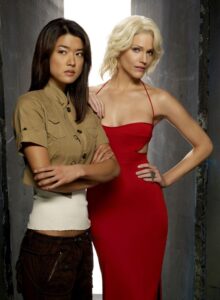
This is where things are completely different from and far more interesting between the original and the re-imagined series. Characters like Starbuck and Boomer – in the original series played by male actors – are now played by female ones. I recall there was a little bit of a hoo-ha at the time about the female casting from a certain old school fanbase (as it hadn’t be done often beforehand). The fact that it was Katee Sackhoff and Grace Park though – both outstanding actors in their own right – made it work just perfectly.
The acting in the re-imagined series is often celebrated for its depth and intensity, as the cast brought layers of emotion and complexity to a dark, high-stakes story about survival. Edward James Olmos, as Commander William Adama, brought a grounded and commanding presence that anchored the series, delivering a deeply paternal but morally nuanced performance. The sheer charisma that Olmos imbues throughout the series is powerful indeed. Mary McDonnell, as President Laura Roslin, portrayed a leader whose vulnerability and resilience were in constant balance, especially as her character faced terminal illness and political strife. Their chemistry added depth to the series’ exploration of leadership.
The aforementioned Katee Sackhoff, as Kara “Starbuck” Thrace, portrayed one of the most volatile and compelling characters with a mix of grit, vulnerability, and unpredictability, while Jamie Bamber’s portrayal of Lee “Apollo” Adama brought a thoughtful, morally conflicted dimension to his role. James Callis, as Dr. Gaius Baltar, delivered a performance marked by paranoia and selfishness tempered with surprising flashes of empathy, making his character one of the series’ most complex and (dare I say it) hated. Tricia Helfer and Grace Park turn in stand out performanaces in their roles as Cylon models, each conveying a range of personalities within the same character types and exploring themes of identity and humanity.
Overall, the ensemble cast brought a depth and grit that matched the show’s ambitious themes, making each character’s journey a compelling part of the series larger, morally challenging story. The cast’s commitment to raw, often uncomfortable emotion elevated the series beyond the sci-fi genre roots of the original series to a very people driven drama about survival, identity, and humanity.
Let us not forget the many guest actors that graced our screens throughout the series. They are many and varied, however I want to mention two in particular: Dean Stockwell puts in a suitably creepy and sinister performance as Brother Cavill (Number One) and Michelle Forbes’ perfomance as Admiral Cain on Battlestar Pegasus. Both outstanding actors, both outstanding performances. There are many more outstanding performances, far too many to mention.
A mention of particular importance
Michael Hogan’s performance as Colonel Tigh is for me, the most powerful and raw portrayals in the series. He brought a gritty, haunted intensity to the role, embodying a deeply flawed man with a long history of trauma, loyalty, and regret. Colonel Tigh is a hardened, loyal friend to Commander Adama, yet his own demons – particularly his struggle with alcoholism and his volatile relationship with his wife Ellen – often place him in self-destructive situations.
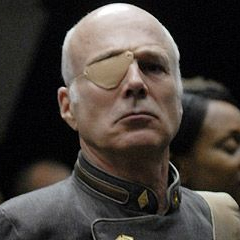
Hogan captured Tigh’s journey with remarkable depth, showing how the character wrestles with self-loathing, love, and a fierce sense of duty that often conflicts with his personal weaknesses. When Tigh discovers he is one of the Final Five Cylons, Hogan’s portrayal shifts, adding layers of shock, existential confusion, and defiance. Through this revelation, Hogan skilfully depicts Tigh’s struggle to reconcile his newfound identity with his loyalty to the human race and his own sense of self.
Hogan’s commitment to Tigh’s gritty realism made the character not only believable but deeply sympathetic, despite his often harsh demeanour. His portrayal of Tigh’s vulnerability and resilience is a focal point for many of the series’ most intense and emotional moments, making his performance an unforgettable one.
Two outstanding Tigh moments:
- He kills his wife, because she has passed important information to the Cylons.
- The moment that Tigh realises that he is a Cylon.
It is Michael Hogan’s performance as Tigh (along with Tricia Helfer’s as Number Six and James Callis’ unctuous Gaius Baltar) that makes this series hands-down my favourite US Series of all time.
Conclusion
It has been twenty years since Battlestar Galactica (the re-imagined series) first aired. I’ve rewatched the whole thing from start to finish, through Caprica and Blood & Chrome five times to date. It’s still as fresh today as it was twenty years ago, and it is still as exciting. And bumsqueaky, of course. I have no doubt whatsoever that I’ll watch it again at some point in the near future.
If you haven’t watched it (and you don’t necessarily have to be a sci-fi fan) please do. It’s absolutely worth it.
Hesitant footnotes from a fan
I’ve said a lot of nice things (that are well deserved) about Battlestar Galactica. But there is just one small niggle that I didn’t enjoy. I wrote about the thing I don’t like here: and it is the “documentary-style” of filming. This is the style where the camera is bouncing up and down and you can’t see a bloody thing. Admittedly Battlestar does it is to great effect, but all the same, it’s dreadfully off-putting!
The franchise lives on
You’ve only to read the main Battlestar Galactica Wikipedia page to see the interest it has garnered over the years – an interest that continues to this day. After the original series several people attempted to reboot (or remake) or continue it – the original Starbuck (Richard Hatch) being one of the main proponents. Sadly, none of the attempts were successful, until Ronald D. Moore came along with the Battlestar Galactica we know today (maybe that was meant to be?).
And so, although it’s been in excess of twenty years since Edward James Olmos and his team of rag tag ships fought off the Cylons, Battlestar Galactica is as popular today as it ever was.
In my book, that’s absolutely nothing less than what it deserves.
So say we all.

